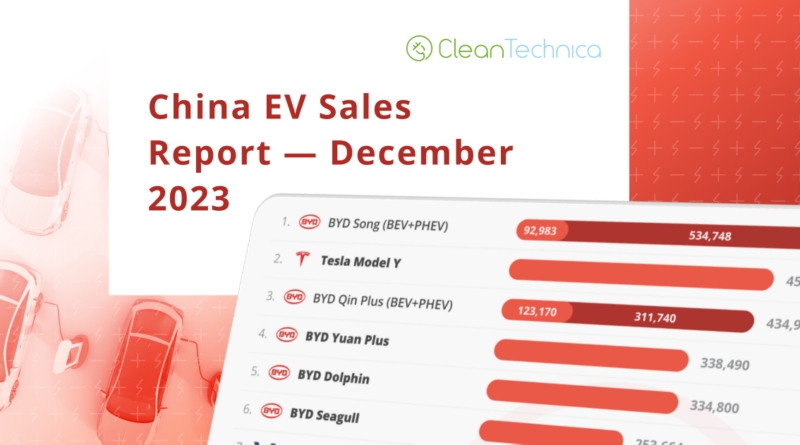
Plugin vehicles in China once again ended the year with a record month, growing by 46% year over year (YoY) in the last month of the year to a record 980,000 units. Interestingly, full electric vehicles (BEVs) grew at a slower pace, growing just 31% to 618,000 units. They were responsible for 63% of the plugin market in December, below the 66% average of 2023, which itself is some 8% below the 2022 final result (74%).
This is explained by the fact that range-extended vehicles have become trendy in China, and with most of them packing 40 kWh-ish battery packs and fast charging capabilities, one can say that the Chevrolet Volt formula has found success in China and is at the forefront of the electrification process in this market. [Editor’s note: More than a decade after the Chevy Volt was introduced! Also, this is often being done in larger vehicles, SUVs, like many argued GM should do a decade ago.]
Looking back, the plugin share progression is nothing less than astonishing. At the end of 2020, we were celebrating a record 6.3% (5.1% BEV) market share, followed by 15% (12% BEV) in 2021 and 30% (22% BEV) in 2022. Now, we’re at 37% (25% BEV).
With the plugin share already at 37% in 2023, and with full electrics (BEVs) alone accounting for 25%, a slowdown in the growth rate is bound to happen, but even with slower rates, expect the Chinese automotive market, the largest in the world, to cross the 50% mark by 2026. By then, BEVs should be responsible for over a third of the sales of the overall market.
If Chinese OEMs wish to continue doubling their sales, as many have been aiming to do, there is one way to do it: exports.

Plugin vehicles in China once again ended the year with a record month, growing by 46% year over year (YoY) in the last month of the year to a record 980,000 units. Interestingly, full electric vehicles (BEVs) grew at a slower pace, growing just 31% to 618,000 units. They were responsible for 63% of the plugin market in December, below the 66% average of 2023, which itself is some 8% below the 2022 final result (74%).
This is explained by the fact that range-extended vehicles have become trendy in China, and with most of them packing 40 kWh-ish battery packs and fast charging capabilities, one can say that the Chevrolet Volt formula has found success in China and is at the forefront of the electrification process in this market. [Editor’s note: More than a decade after the Chevy Volt was introduced! Also, this is often being done in larger vehicles, SUVs, like many argued GM should do a decade ago.]
Looking back, the plugin share progression is nothing less than astonishing. At the end of 2020, we were celebrating a record 6.3% (5.1% BEV) market share, followed by 15% (12% BEV) in 2021 and 30% (22% BEV) in 2022. Now, we’re at 37% (25% BEV).
With the plugin share already at 37% in 2023, and with full electrics (BEVs) alone accounting for 25%, a slowdown in the growth rate is bound to happen, but even with slower rates, expect the Chinese automotive market, the largest in the world, to cross the 50% mark by 2026. By then, BEVs should be responsible for over a third of the sales of the overall market.
If Chinese OEMs wish to continue doubling their sales, as many have been aiming to do, there is one way to do it: exports.
TEL : +86-132 6020 9406
EMAIL : lee2802@vip.126.com
WECHAT : vivianlee2802
ADD. : No.18 of Jianshe Road, Liangxiang Kaixuan Street, Fangshan District, Beijing,China

QR Code for WeChat
